Proposed Residential Infill Project (RIP) in Portland Will Do More Harm Than Good
For over two years, the City of Portland and the Bureau of Planning and Sustainability (BPS) has been working on an initiative referred to as the Residential Infill Project (RIP). It began as a response to the demolition epidemic and the rampant replacement of modest-priced homes with expensive McMansions. Many hoped it would outline ways in which to add compatible density while retaining the livability of our older neighborhoods.
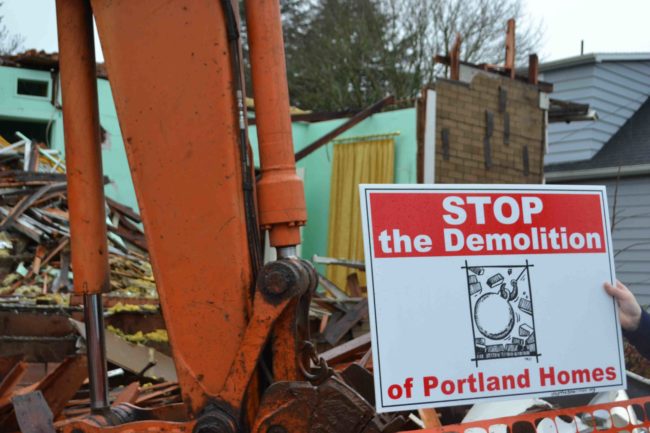 Restore Oregon agrees that neighborhoods and historic districts need to evolve. We enthusiastically support initiatives that will add density through ADUs, internal conversions of large homes into multiple units, and compatible infill on vacant lots. But we adamantly oppose the ongoing demolition and replacement of modest-sized homes with oversized, expensive houses that only exacerbate the affordability crisis and destroy community character.
Restore Oregon agrees that neighborhoods and historic districts need to evolve. We enthusiastically support initiatives that will add density through ADUs, internal conversions of large homes into multiple units, and compatible infill on vacant lots. But we adamantly oppose the ongoing demolition and replacement of modest-sized homes with oversized, expensive houses that only exacerbate the affordability crisis and destroy community character.
If building more high-end homes had the trickle-down effect of lowering prices, then the San Francisco Bay Area’s median home price wouldn’t be over $825,000!
Over several rounds of hearings and revisions, RIP has morphed into a set of proposals that include some welcome limits on the scale, height, and set-backs of new housing. However, a proposed “a” overlay zone covering the three-quarters of the central city is alarming. It will effectively re-zone these neighborhoods, and despite the positive spin on the BPS website, it:
- Does little to create affordable housing.
- Does not curb the demolition epidemic or displacement of renters.
- Fails to provide real incentives to retain existing, naturally more-affordable homes.
- Drastically changes the livability of neighborhoods.
- Ignores key aspects of the 2035 Comprehensive Plan and directives given by City Council.
- And will net merely a couple hundred additional housing units over 20 years!
Without significantly more incentives or regulations to retain existing homes, tens of thousands of Portland renters could be displaced or priced out by RIP-induced demolitions.
Check out this map (https://arcg.is/WiTf9 ) created by Meg Hansen, a Portland housing and preservation advocate and all-around data expert, that illustrates the proposed “a” overlay zone and number of Single Family Residential rental units that would be effected. It also contains layers for median family income, communities of color, vulnerable populations, and gentrification risk zones.
We have been working with a coalition of neighborhood associations and preservationists on this issue. One group, United Neighborhoods for Reform, has compiled their assessment of the current RIP proposal which we are sharing here. We encourage those who are concerned about demolitions, affordability, and balancing density with livability to submit testimony or testify in person at one of two hearings being held by the Planning and Sustainability Commission on May 8th and 15th @ 5:00pm.
Complete information and how to testify can be found at: www.portlandoregon.gov/bps/infill
United Neighborhoods for Reform (UNR) Assessment of RIP
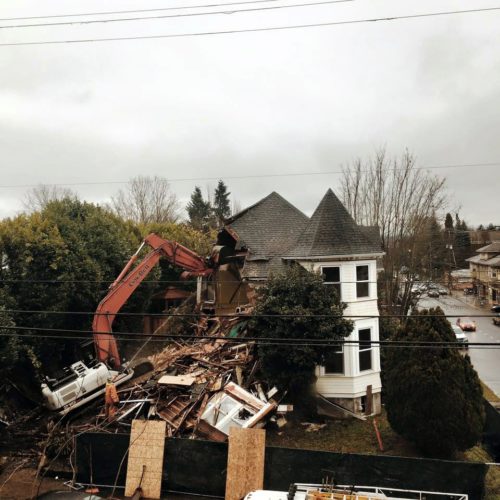 Overall:
Overall:
- The RIP will not provide affordable housing.
- The RIP operates in a vacuum. The proposal does not mesh well with Better Housing by Design, the Comprehensive Plan or any of the other fractured housing policies we have in this city.
- The RIP is not consistent with the city’s transportation and infrastructure policies and goals.
- The RIP violates the purpose of zoning: consistency, predictability and transparency.
- The RIP process is a product of ever changing goals.
- The RIP does not respect the housing choices families have already made.
- The City’s goal should be to bring people together but RIP does the opposite.
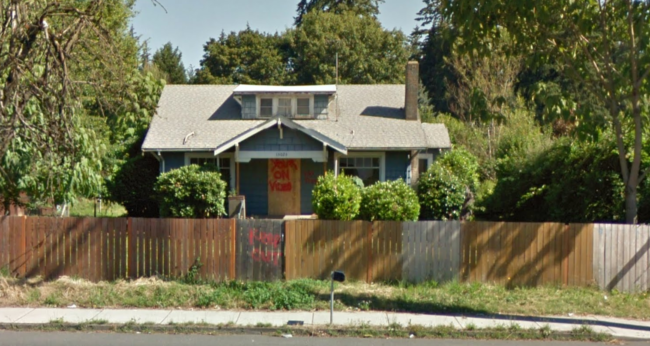 The RIP will not result in homes affordable to most people.
The RIP will not result in homes affordable to most people.
- The most affordable house is the one already standing. RIP does nothing to encourage retention of existing relatively affordable homes.
- By pushing more density into to well-established, i.e., “complete neighborhoods,” which come with associated high house and land prices, developers will not build homes affordable to most people in these areas.
- The city needs to encourage the development of new, complete, amenity rich neighborhoods and provide the needed infrastructure to assure this happens. A BPS spokesperson at the February 13, 2018 briefing for PSC acknowledged this need for creating new neighborhoods saying: “We can’t grow without creating new complete neighborhoods.”
The RIP does not incorporate the amendments approved by City Council on December 7, 2016.
- The RIP ignores the Council’s amendment disallowing rezoning of narrow lots in R5 zones to R2.5.
- The RIP ignores the Council’s amendment to provide options for the housing opportunity overlay zone map.
- The RIP ignores the Council’s amendment allowing front loaded garages on narrow lots.
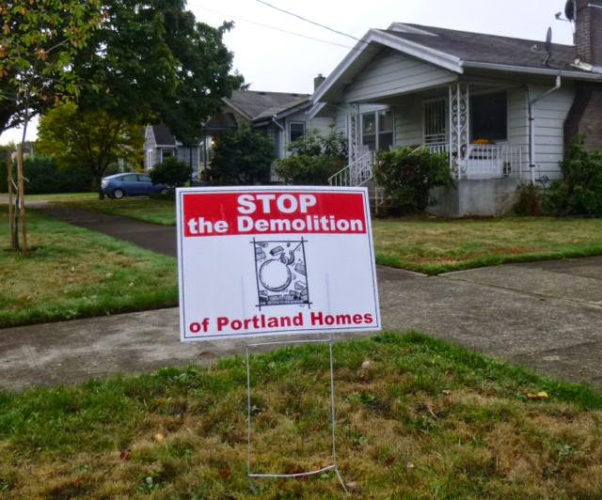
The RIP does not support major goals of the 2035 Comprehensive Plan and Zoning Code.
- The Buildable Land Inventory states there is sufficient land to meet Portland’s growing population for the next twenty years without changing zoning and allowable density.
- Allowing duplexes and triplexes in the Single Dwelling Zone makes large portions of these areas into de facto multifamily zones without going through the process of changing the zoning designation. This does not lead to predictability and transparency.
- Using a one-size-fits-all formula encourages demolitions of smaller houses, provides inequitable opportunities, and rejects protection of neighborhood character and historic context.
- Dispersed higher density development is contrary to the Comprehensive Plan directives to focus density around centers and transportation hubs. This results in greater auto dependency and inefficient use of infrastructure.
- The RIP does little to encourage the development of smaller single family houses, the most desired type of housing stock.
- The RIP does not encourage the development of new high amenity, walkable neighborhoods.
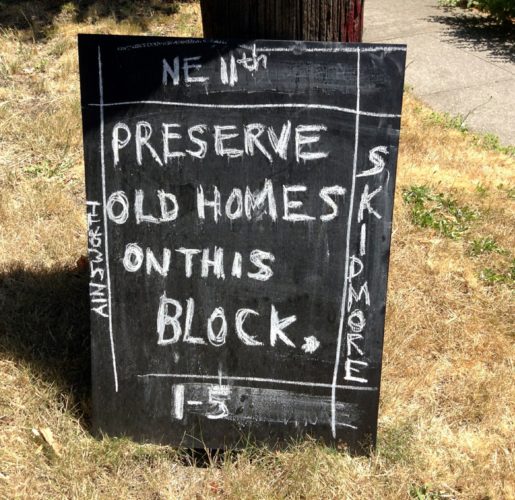 The RIP will result in more displacement of renters and vulnerable homeowners.
The RIP will result in more displacement of renters and vulnerable homeowners.
- Within the RIP “a” overlay there currently are many rental units dispersed throughout the area.
- BPS planners acknowledge displacement of renters as a potential outcome of the up-zoning and “opportunity” overlay but only exempt some small areas in three neighborhoods and East Portland. This analysis grossly underestimates the potential for displacement.
- Many renters already have been displaced from the “opportunity” overlay. Many more rental homes will be demolished under the RIP because builders profit from tearing down an affordable rental home and building bigger houses or multiple market-rate units.
- For years homeowners in Portland have been receiving never-ending postcards and letters from developers offering to buy their houses for cash without any need to do repairs and without any need to involve realtors. This is predatory behavior particularly when it targets older homeowners.
The most affordable and “greenest” house is the one already standing; RIP does little to encourage retention of existing houses.
- Bonus units should only be allowed if the existing house is retained.
- The exterior of the existing house should remain reasonably intact.
Promoting ADUs is a positive but only if use is restricted to long-term renters
- Since 2012 the City of Portland has been encouraging development of ADUs by eliminating system development fees.
- The RIP further encourages ADU development by allowing more than one ADU on a property.
- ADU development is a positive for Portland but only if the ADU is used to help with the housing crisis, i.e., only if the ADU use is restricted to a full-time renter.
- Furthermore, taxpayers should only be subsidizing development of ADUs that are used for full time rentals, not vacation rentals.
Other, more progressive cities, are doing far more than Portland to analyze the potential impacts of new infill activity.
- Tacoma, Washington has chosen to do a pilot program to promote residential infill development types and housing choice, while ensuring that such development demonstrates high quality building and site design that is responsive to and harmonious with neighborhood patterns. The pilot is intended to develop a body of successful, well-regarded examples of innovative residential infill in order to inform a future Council decision on development regulations and design standards for some or all of these infill housing types. Read the link for more information: http://cms.cityoftacoma.org/planning/Residential%20Infill%20Pilot%20Program/Tacoma%20Infill%20Pilot%20Program%20Handbook%20(Nov2016).pdf
- The City of Los Angeles put in place code to preserve the scale and character of its irreplaceable single-family neighborhoods. Read the link for more information: http://www.nomoremcmansionsinlosangeles.org/the-conclusion
The housing option “a” overlay does not follow the intent of the missing middle housing concept.
- “Missing middle” housing is designed to transition between higher density and detached single family housing. The housing options overlay does not make this transition; there are no adjoining single family housing areas.
- Based on the Comprehensive Plan, middle housing and higher density should be located around centers. The RIP does not do this.
- What the RIP overlay does do is promote helter-skelter development with multi-units allowed randomly throughout areas of single family homes. In effect the entire overlay becomes a multi-unit zone.
These portions of the April 2018 RIP proposal are positive step:
- Reduced scale of houses, provided that all habitable space be included in the FAR (floor area ratio).
- Reduced height limits
- Increased front setbacks
- Limiting the height of the first floor above grade
- Incentives for affordable housing. (However, we oppose allowing developers to purchase the right to build bigger homes by contributing to an in-lieu fund)
- Incentives for historic preservation, including flexibility for internal conversions of existing homes
(Reprinted with permission)

